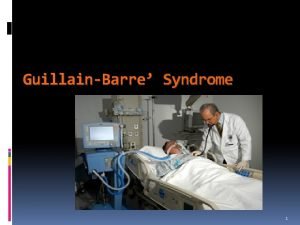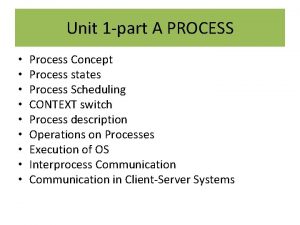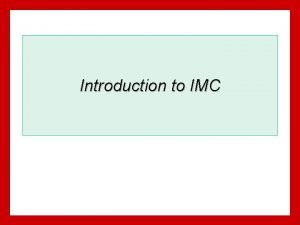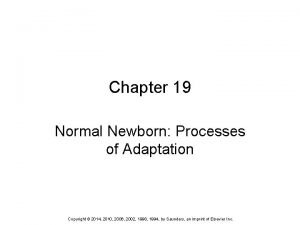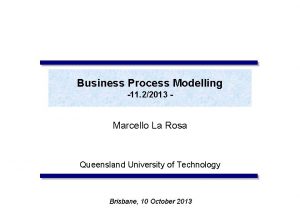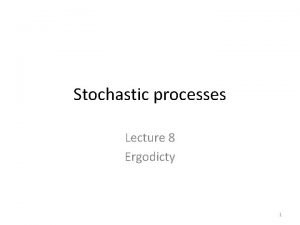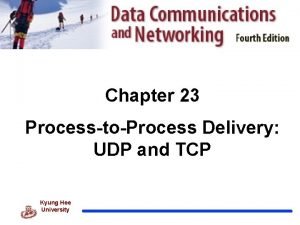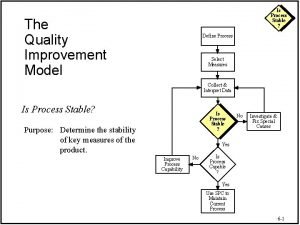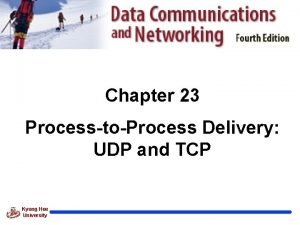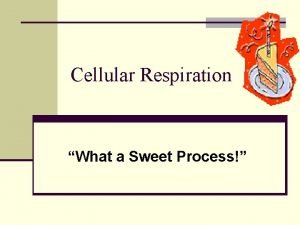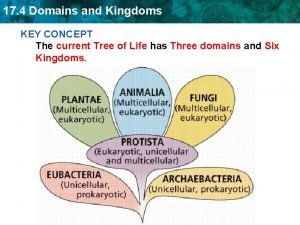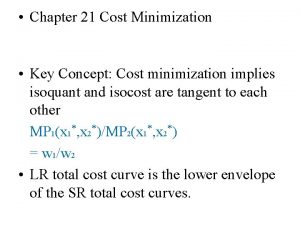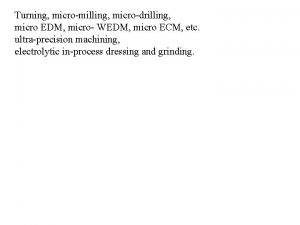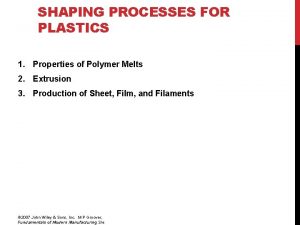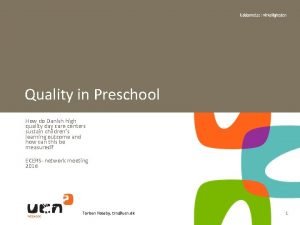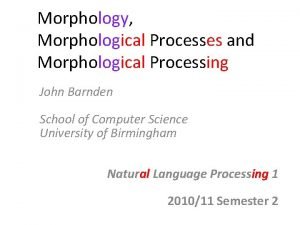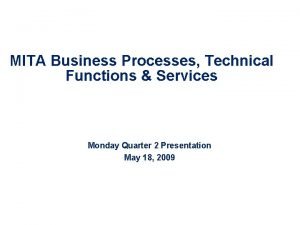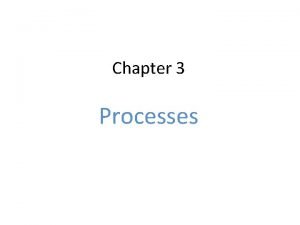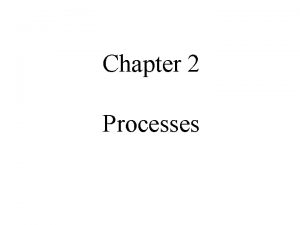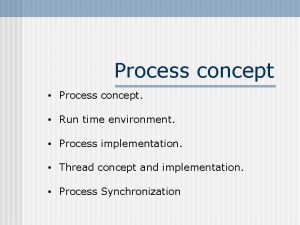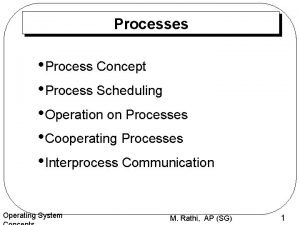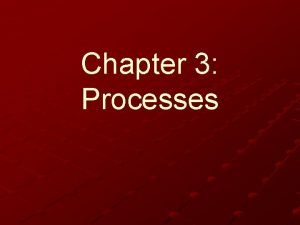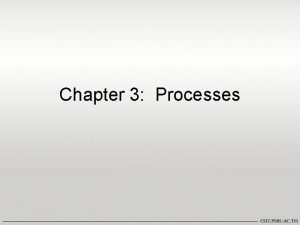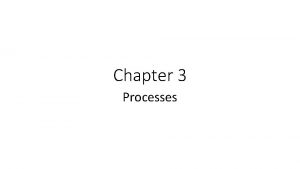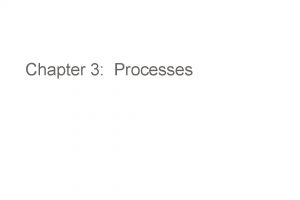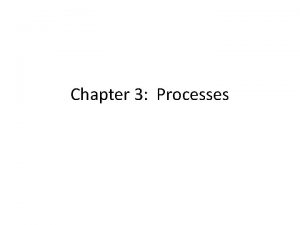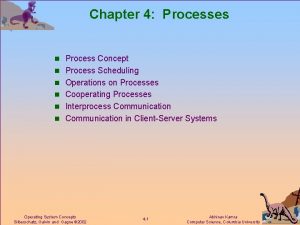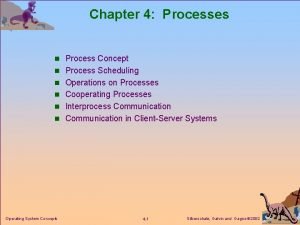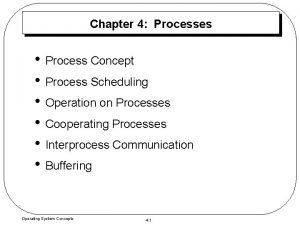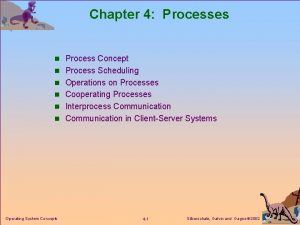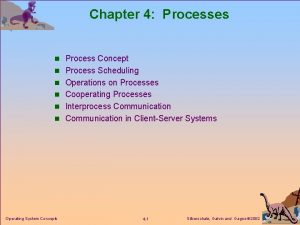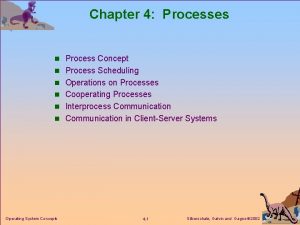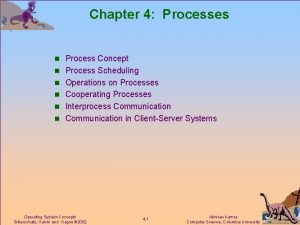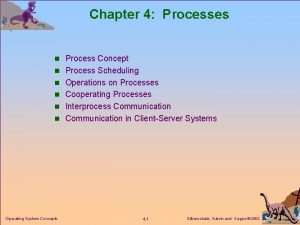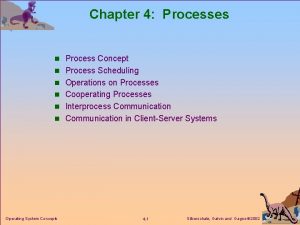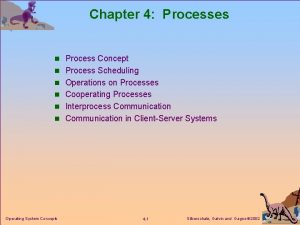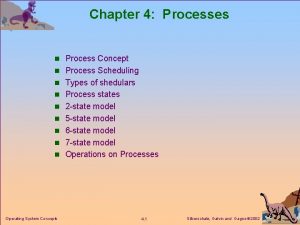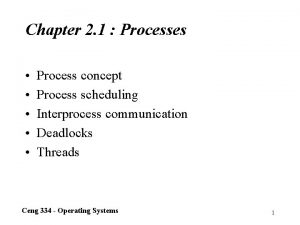Chapter 3 Processes Chapter 3 Processes Process Concept





























































- Slides: 61

Chapter 3: Processes

Chapter 3: Processes • • • Process Concept Process Scheduling Operations on Processes Cooperating Processes Interprocess Communication in Client-Server Systems

Process Concept • An OS executes a variety of programs: – Batch system – jobs – Time-shared systems – user programs or tasks • Process ≈ Task ≈ Job • Process – a process is an instance of a program in execution. – +Program code (text section) – +program counter & registers (CPU status) – +stack – +data section

Process in Memory MAX OS kernel Kernel space stack heap uninitialized data text (code) 0 user space

Process in Memory MAX int a; OS kernel int b = 3; Kernel space stack int main() { int c; heap int* d = (int*)malloc(4); uninitialized data } initialized data text (code) 0 user space

Process in Memory MAX OS kernel Kernel space stack initialized data heap text (code) uninitialized data header initialized data The executable program file text (code) 0 user space

/proc/

/proc/(process ID)

/proc/(process ID)/maps offset dev i-node : = file id

Process State (Unix) fork() execv() Parent process wait() Zombie 殭屍 +TCB +MEM +…

Process Control Block (PCB) Information associated with each process/task • Process state • Program counter & general registers • Scheduling information • Memory-management information • Accounting information • I/O status information • List of open files • … Definition: Process control block ≈ Task control block

The Linux Task Control Block state Accounting CPU registers memory Open files

CPU Switch From Process to Process (context switch)

Process Scheduling Queues Ready. Q Waiting. Q Definition: Waiting queue ≈ device queue

Representation of Process Scheduling Device queue

Schedulers • Long-term scheduler (or job scheduler) – selects which processes should be load into the ready memory – controls the degree of multiprogramming – selects a good process mix of I/O-bound and CPUbound processes – Multi-programmed batch OS • Short-term scheduler (or CPU scheduler) – selects which process should be executed next and allocates CPU – Time-shared OS

Schedulers (Cont. ) • I/O-bound process – I/O time >> CPU time – Example: ftp server i/o CPU i/o • CPU-bound process – CPU time >> I/O time – Example: image processing CPU I/O CPU

Addition of Medium Term Scheduling To increase the degree of multiprogramming To reduce the degree of multiprogramming

Context Switch (ctx-sw) • Definition: CPU switches to another process • Context-switch time is overhead – the operating system does no useful work while switching • Time dependent heavily on hardware support

Context Switch (ctx-sw) Task A User space Task B CPU scheduler Kernel space Task control block

Process Creation • Parent process create children processes forming a tree of processes • Resource sharing – Parent and children share all resources – Children share subset of parent’s resources – Parent and child share no resources • Execution – Parent and children execute concurrently – Parent waits until children terminate

Process Creation (Cont. ) • Address space – Child duplicate of parent – Child has a program loaded into it • UNIX examples – Fork() system call creates new process – Exec() system call used after a fork to replace the process’ memory space with a new program




fork() - POSIX pid_t pid; pid = fork(); if (pid == 0) { printf(“childn”); } else { printf(“parentn”); }

fork() - POSIX pid_t pid; pid = fork(); if (pid == 0) { printf(“childn”); } else { printf(“parentn”); }

fork() - POSIX parent child pid_t pid; pid = fork(); if (pid == 0) { printf(“childn”); } else { printf(“childn”); } printf(“parentn”); } else { printf(“parentn”); }

fork() - POSIX parent child pid_t pid; pid = fork(); pid == child’s pid = fork(); if (pid == 0) { printf(“childn”); } else { printf(“childn”); } printf(“parentn”); } pid == 0 else { printf(“parentn”); }

fork() - POSIX parent child pid_t pid; pid = fork(); if (pid == 0) { printf(“childn”); } else { printf(“childn”); } printf(“parentn”); } else { printf(“parentn”); }

fork() - POSIX parent child pid_t pid; pid = fork(); if (pid == 0) { printf(“childn”); } else { printf(“childn”); } printf(“parentn”); } else { printf(“parentn”); }

fork() - POSIX parent pid_t pid; pid = fork(); if (pid == 0) { printf(“childn”); } else { printf(“parentn”); }

fork() - POSIX

Process Creation (Cont. ) (in kernel space) void sys_fork() { sys child. TCB = new TCB; memcopy(parent. TCB, child. TCB); //modify some fields of child. TCB add. Task(child. TCB); set. Task. Rdy. To. Run(child. TCB); call_scheduler(); if (current. TCB == parent. TCB) return child. TCB. pid; else return 0; }

Process Creation (csh) #ls backup etc lost+found net sbin tmp bin home media opt selinux usr boot home 1 misc proc srv var dev lib mnt root sys #

Process Creation (csh) csh ls ls

An example: C language (parent) int main() pid = { 8088 pid_t pid; /* fork another process */ pid = fork(); if (pid == 0) { /* child process */ execlp("/bin/ls", "ls", null); } else { /*parent process*/ wait (NULL); printf ("Child Complete"); exit(0); } }

An example: C language (child) int main() pid = 0 { pid_t pid; /* fork another process */ pid = fork(); if (pid == 0) { /* child process */ execlp("/bin/ls", "ls", null); } else { /*parent process*/ wait (NULL); printf ("Child Complete"); exit(0); } }

A tree of processes on a typical Solaris

Process Termination • Process executes last statement and asks the operating system to delete it (exit) – Output data from child to parent (via wait) – Process’ resources are deallocated by operating system • Parent may terminate execution of children processes (abort) – Child has exceeded allocated resources – Task assigned to child is no longer required – The parent is exiting • Some OS do not allow child to continue if its parent terminates

Cooperating Processes • Independent process cannot affect or be affected by the execution of another process • Cooperating process can affect or be affected by the execution of another process • Advantages of process cooperation – Information sharing – Computation speed-up – Modularity – Convenience

Producer-Consumer Problem • Paradigm for cooperating processes, producer process produces information that is consumed by a consumer process – unbounded-buffer places no practical limit on the size of the buffer – bounded-buffer assumes that there is a fixed buffer size

Bounded-Buffer – Shared-Memory Solution • Shared data int BUFFER_SIZE = 10 typedef struct {. . . } item; struct item buffer[BUFFER_SIZE]; int in = 0; int out = 0; • Solution is correct, but can only use BUFFER_SIZE-1 elements

Bounded-Buffer – Insert() while (true) { item = input(); /* Produce an item */ while (((in + 1) % BUFFER_SIZE) == out) ; /* do nothing -- no free buffers */ buffer[in] = item; in = (in + 1) % BUFFER_SIZE; }

Bounded Buffer – Remove() while (true) { while (in == out) ; // do nothing -- nothing to consume // remove an item from the buffer item = buffer[out]; out = (out + 1) % BUFFER SIZE; output(item); }

Interprocess Communication (IPC) • Mechanism for communication and to synchronization • Message system provides two operations: – send(void* message) – receive(void* message) • If P and Q wish to communicate, they need to: – establish a communication link between them – exchange messages via send/receive • We are considered with the link’s logical implementation, not the physical implementation

Implementation Questions • How are links established? • Can a link be associated with more than two processes? • How many links can there be between every pair of communicating processes? • What is the capacity of a link? • Is the size of a message that the link can accommodate fixed or variable? • Is a link unidirectional or bi-directional?

Communications Models

Direct Communication • Processes must name each other explicitly: – send (P, message) – send a message to process P – receive(Q, message) – receive a message from process Q • Properties of communication link – Links are established automatically – A link is associated with exactly one pair of communicating processes – Between each pair there exists exactly one link – The link may be unidirectional, but is usually bidirectional

Indirect Communication • Messages are directed and received from mailboxes (also referred to as ports) – Each mailbox has a unique id – Processes can communicate only if they share a mailbox • Properties of communication link – Link established only if processes share a common mailbox – A link may be associated with many processes – Each pair of processes may share several communication links – Link may be unidirectional or bi-directional

Indirect Communication • Operations – create a new mailbox – send and receive messages through mailbox – destroy a mailbox • Primitives are defined as: send(A, message) – send a message to mailbox A receive(A, message) – receive a message from mailbox A

Indirect Communication • Mailbox sharing – P 1, P 2, and P 3 share mailbox A – P 1, sends; P 2 and P 3 receive – Who gets the message? • Solutions – Allow a link to be associated with at most two processes – Allow only one process at a time to execute a receive operation – Allow the system to select arbitrarily the receiver. Sender is notified who the receiver was.

Synchronization • Message passing may be either blocking or nonblocking • Blocking is considered synchronous – Blocking send has the sender block until the message is received – Blocking receive has the receiver block until a message is available • Non-blocking is considered asynchronous – Non-blocking send has the sender send the message and continue – Non-blocking receive has the receiver receive a valid message or null

Buffering • Queue of messages attached to the link; implemented in one of three ways 1. Zero capacity – 0 messages Sender must wait for receiver (rendezvous) 2. Bounded capacity – finite length of n messages Sender must wait if link full 3. Unbounded capacity – infinite length Sender never waits

Client-Server Communication • Sockets • Remote Procedure Calls • Remote Method Invocation (Java)

Sockets • A socket is defined as an endpoint for communication • Concatenation of IP address and port • The socket 161. 25. 19. 8: 1625 refers to port 1625 on host 161. 25. 19. 8 • Communication consists between a pair of sockets

Socket Communication

Remote Procedure Calls • Remote procedure call (RPC) abstracts procedure calls between processes on networked systems. • Stubs – client-side proxy for the actual procedure on the server. • The client-side stub locates the server and marshalls the parameters. • The server-side stub receives this message, unpacks the marshalled parameters, and performs the procedure on the server.

Execution of RPC

Remote Method Invocation • Remote Method Invocation (RMI) is a Java mechanism similar to RPCs. • RMI allows a Java program on one machine to invoke a method on a remote object.

Marshalling Parameters
 Concurrent processes are processes that
Concurrent processes are processes that The distance between the real self and ideal self
The distance between the real self and ideal self Pengertian marketing concept
Pengertian marketing concept What processes are crucial to the ipde process
What processes are crucial to the ipde process Concept map of assessment
Concept map of assessment Discuss in detail the concept and process of hydrosere'
Discuss in detail the concept and process of hydrosere' Pollination concept map
Pollination concept map What is process concept
What is process concept Process concept
Process concept Elements of communication
Elements of communication Chapter 19 normal newborn processes of adaptation
Chapter 19 normal newborn processes of adaptation 7 types of jaycustomers
7 types of jaycustomers Coronoid process and coracoid process
Coronoid process and coracoid process Substantive vs procedural due process
Substantive vs procedural due process Process hierarchy in process management
Process hierarchy in process management Ergodic process in random process
Ergodic process in random process What is process to process delivery
What is process to process delivery Condylar process and coronoid process
Condylar process and coronoid process Process capability
Process capability Process-to-process delivery
Process-to-process delivery Sweet process
Sweet process Sweet evaluation
Sweet evaluation Difference between old and new concept of marketing
Difference between old and new concept of marketing Concept mapping chapter 11 genetic disorders
Concept mapping chapter 11 genetic disorders Concept mapping circulation in humans chapter 34
Concept mapping circulation in humans chapter 34 Chapter 28 section 1: fishes study guide answer key
Chapter 28 section 1: fishes study guide answer key Chapter 28 fishes and amphibians concept mapping answer key
Chapter 28 fishes and amphibians concept mapping answer key Concept mapping chapter 28 fishes and amphibians
Concept mapping chapter 28 fishes and amphibians Chapter 25 concept review conceptual physics waves
Chapter 25 concept review conceptual physics waves Chapter 17 domains and kingdoms concept mapping answers
Chapter 17 domains and kingdoms concept mapping answers New concept english 3 text
New concept english 3 text Chapter 34 section 1 the circulatory system
Chapter 34 section 1 the circulatory system Meiosis and genetic variation usatestprep
Meiosis and genetic variation usatestprep Combination table in product design
Combination table in product design Good to great hedgehog examples
Good to great hedgehog examples Adventitious crisis
Adventitious crisis New concept chapter 21
New concept chapter 21 Section quick check chapter 10 section 1 meiosis answer key
Section quick check chapter 10 section 1 meiosis answer key Good to great chapter 5 hedgehog concept
Good to great chapter 5 hedgehog concept New concept chapter 19
New concept chapter 19 Proximal processes
Proximal processes Word formation processes
Word formation processes Study of behavior and mental processes
Study of behavior and mental processes Reading processes
Reading processes Hydration weathering of rocks
Hydration weathering of rocks What is a subaerial process
What is a subaerial process Biological weathering
Biological weathering Micro machining processes
Micro machining processes Mass wasting processes
Mass wasting processes Wharton risk management program
Wharton risk management program What are the 7 hr processes?
What are the 7 hr processes? Mass wasting processes
Mass wasting processes Speech production
Speech production Characteristics of polymers
Characteristics of polymers Proximal processes
Proximal processes Six generic administrative processes
Six generic administrative processes In chemical dehumidification process
In chemical dehumidification process Behavior patterns or mental processes that interfere
Behavior patterns or mental processes that interfere Assimilation rules in phonology
Assimilation rules in phonology What is the transformative process of operations management
What is the transformative process of operations management Morphological processing linguistics
Morphological processing linguistics Architecture review board template
Architecture review board template




